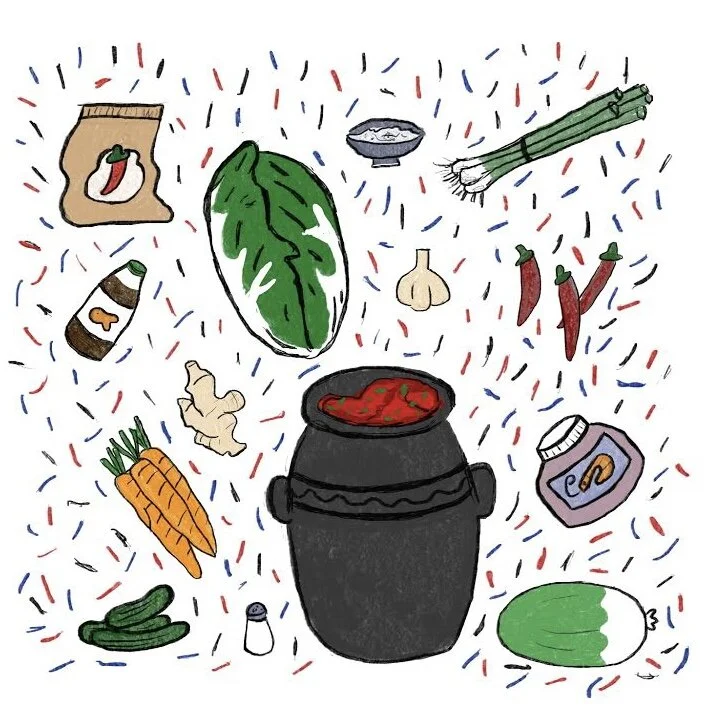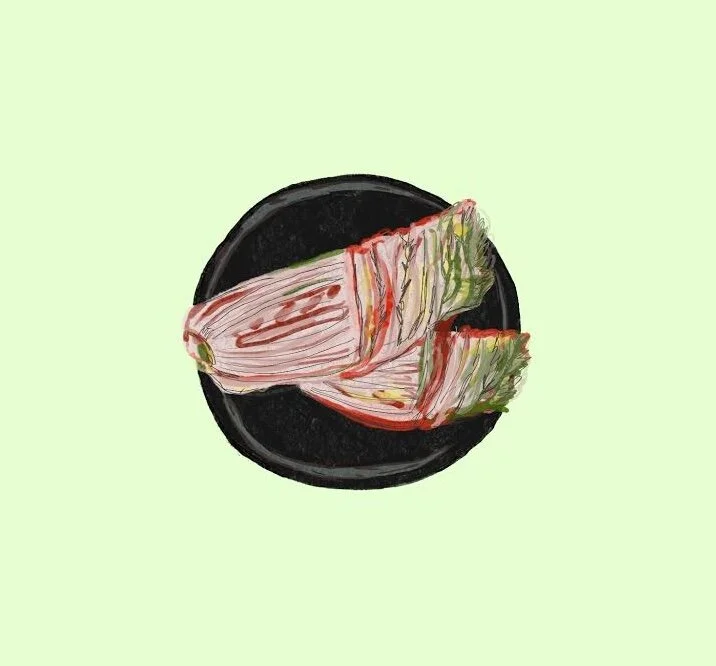My Life with Kimchi
Photograph: Heli Yoon.
Words by Heli Yoon.
As a youth, I hated kimchi.
A few times a year, my house would turn into a kimchi factory. The bathtub would be filled with wombok cabbage soaking in a salt bath, and the floor of the kitchen was a minefield of giant buckets of onions, carrots and red chilli paste. It required the whole family to get involved (Mum being head chef, and the rest of us her assistants). Mum would slice the cabbage, and my sister and I would salt the leaves; Mum would make the red chilli paste and ask Dad to bring her the ingredients, and so on and so forth. The whole operation would often yield several giant tubs of kimchi, enough to be eaten by the family and shared amongst our community for months.
I dreaded it all. Mostly because it meant I could never invite my friends over. The smell was too pungent, and the self-loathing Asian in me knew that the smell would signal to my friends that I was different, that I did not belong and that I was not one of them. I had too many memories of kids at school, and even friends in my own home, pinching their noses at the smell and asking what ‘fermented’ meant. To this day I still struggle with this association between kimchi and the feeling of being an outsider.
“To this day I still struggle with this association between kimchi and the feeling of being an outsider.”
Perhaps it is because of this context that I feel uneasy when I open my white friends’ fridges and see an overpriced glass jar of kimchi, or when I look at the menus of cafes in Fitzroy and see kimchi underneath an optional sides tab alongside halloumi. I grew up with and ate kimchi when it was a symbol of difference, before it had been culturally appropriated by the very people who often love my culture’s food but don’t necessarily respect my people.
David Chang, one of my favourite celebrity chefs, has used his platform to shed light on food prejudice and cultural appropriation. On a Stephen Colbert segment, Chang brings out a platter of hot dogs, some with sauerkraut and some with kimchi. Chang makes it a point to say that the two condiments are the same: fermented cabbage. But kimchi, unlike sauerkraut, has historically had a reputation for being too pungent and different. In doing so, Chang points out how prejudice permeates the way we as a society perceive and experience food, and the way Westerners have historically weaponised food as a way to reinforce difference.
“Westerners have historically weaponised food as a way to reinforce difference.”
Illustration: Heli Yoon.
Chang’s Netflix special Ugly Delicious, focuses each episode on a specific dish that delves into the history of certain dishes and the harmful effects of cultural appropriation. In some of these episodes Chang talks candidly about how he feels with the rise of Korean fried chicken and kimchi, and the internal conflict he experiences between wanting to share Korean food with the world, but also hating the way it has been appropriated by Westerners. Westerners who first never had to struggle with the racial politics behind the food; second, may not understand the context behind the food; and third, capitalise on and monetise a food that is not theirs to do so. All of Chang’s sentiments hit home for me and accurately verbalised the feelings I had always considered irrational and bitter.
Things changed when I moved out of home. For the first time, kimchi wasn’t available at my fingertips and I found myself craving it. I missed the flavour bomb of chilli, pickle, umami, garlicky freshness and the way it effortlessly accompanied every dish. Creamy pasta? Kimchi on the side. Chicken salad? Kimchi on the side. Pizza? You guessed it – kimchi on the side. Every time I went home to see my family, my mum would try and hide bags of kimchi in my bag so I would take it back to my sharehouse. “Heli, make your housemates kimchi pancakes or kimchi fried rice, they’d love it” she would say. For the first few months I was reluctant to take it home, telling my mum I had some in the fridge already or that I had too much food to eat that week. In reality, I said no in fear of the foreign smell kimchi would introduce to the fridge I shared with my white housemates.
Illustration: Heli Yoon.
Eventually my craving for kimchi broke through this fear. I went to KT Mart and bought a bag of kimchi (never buy kimchi that comes in glass). My housemates weren’t home that afternoon, and I made a simple kimchi tuna stew. It was the first time I had cooked something with kimchi without my mum being on standby. My relationship with kimchi only grew from there, and the more dishes I could make with kimchi the prouder I became of Korea’s national food. “Check out these kimchi pancakes I made with just three ingredients” I would say to my friends (kimchi pancakes in its simplest form is made of kimchi, flour and water). I now cook kimchi in my white sharehouse without qualms, having finally come to the realisation that kimchi is in fact very cool.
Kimchi originated during a time in Korea when survival was a priority. In ancient times, Koreans started fermenting their food with salt out of necessity so there was the guarantee of fresh food during the winter, and the traditional method to age kimchi was to place it in earthenware pots and bury them under the ground. My parents still use this method, burying their kimchi in the yard on the side of their suburban house. They learnt this from generations before them, just like I will teach it to the generation after me. What this rich history tells me is that my people are survivors, and that they hustle to ensure their families always eat delicious, nutritious food.



